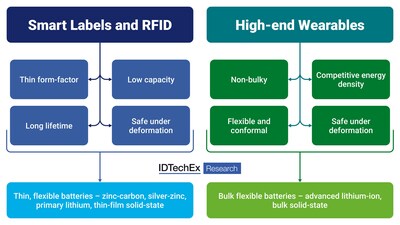From Smart Labels to Wearables: IDTechEx Explores the Limits of Flexible Battery Applications
Comunicato Precedente

Comunicato Successivo

The second category includes advanced lithium-ion and bulk solid-state technologies –the less mature flexible battery technologies. Both are based on rechargeable lithium-ion technologies. Advanced lithium-ion, in this case, describes a battery structure that is similar in chemistry to traditional lithium-ion cells but with innovations that enhance flexibility, e.g., cell packaging or electrolyte. Both liquid electrolyte batteries and semi-solid polymer electrolyte batteries can be included in this category. Bulk solid-state describes a non-thin battery with a solid-state electrolyte, though it need not be 100% solid. Examples of solid-state electrolytes include ceramics and sulfides.
The advantages of flexible batteries are self-evident. A battery that can be rolled, stretched, and bent without losing functionality could prove a significant advantage in the right use case. However, flexible batteries are competing with significantly cheaper traditional technologies such as coin cells. For comparison, coin cells can be less than US$0.50/Wh, while the cheapest flexible battery options are around US$3/Wh. In fact, some technologies cost tens of dollars per Wh. In most use cases, the price of flexible batteries is too high to warrant their use. Instead, suppliers have needed to find niches where extreme flexibility is required, and which are relatively price-insensitive, high-end, specific form-factor applications.
Smart labels have become the primary niche for the first category of low-capacity batteries. Thin batteries, usually printed, are integrated into labels, tags, and sensors that are used for quality control and logistics in industry settings. For example, RFID tags with temperature sensors or chemical sensors are used to monitor produce. The advantage of these tags is significant – produce that would otherwise be lost in transit due to poor temperature control can be saved, reducing waste. Other types of smart labels are used to communicate the position and condition of shipments. Not all smart labels use flexible batteries, however increasingly flexible battery companies have targeted this application. Thinness is the major driver of flexible battery uptake in this instance. Thin labels require thin batteries, which happen to be flexible. While flexibility is an advantage when the label is applied to a curved or irregular surface, in most cases, it is not a requirement. Zinergy and CCL Design (after the acquisition of Imprint Energy) are two flexible battery players who have increasingly targeted this niche. The flexible battery market for smart labels and RFID tags is valued at US$14.3 million in 2025 and is expected to grow with a CAGR of 23.9% over the next decade.
Meanwhile, companies supplying the second category of higher-capacity batteries are increasingly focusing on wearables applications. Wearables include a diverse range of products, from hearables and smartwatches to XR headwear and e-textiles. Unlike consumer electronics, products worn on the body frequently require tailored form factors as they must be comfortable when worn. As a result, wearables companies have shown interest in curved and flexible battery options in the past as a means of removing unnecessary bulk. However, the flexible batteries of the past were unable to meet wearable product requirements for energy density and lifetime. Only recently has flexible battery supply begun to align with the demand for wearables.
Advanced lithium-ion and bulk solid-state flexible batteries have begun to move from the development stage into semi-commercialization, finally providing energy storage solutions that can meet energy density and lifetime requirements while still retaining a flexible form factor. Suppliers of both technologies have targeted wearables opportunities, especially wrist-worn wearables and electronic headwear. Low-end, mass-produced hearables and wrist-worn wearables make up the largest proportion of the overall wearables market but present no opportunity for flexible batteries, and the high cost of flexible battery options cannot be justified for low-cost, mass-produced products. However, the wearables market still presents significant opportunities at the high end. LiBEST, for example, is a Korean company that, since 2024, has focused on advanced lithium-ion batteries for XR headsets and high-end hearables, where products are price-insensitive, and bulkiness is not favored. The total wearables market for flexible batteries (which includes skin patches) is valued at US$43.3 million in 2025 and is expected to grow with a CAGR of 21.6% over the next decade.
The overall flexible battery market remains small, at just US$71.7 million in 2025, compared to a global lithium-ion battery market of over US$50 billion. IDTechEx's latest report, "Flexible Batteries Market 2025-2035: Technologies, Forecasts, and Players", discusses opportunities and growth for flexible battery players over the next decade.
To find out more about this report, including downloadable sample pages, please visit www.IDTechEx.com/Flex.

For the full portfolio of energy storage and batteries market research available from IDTechEx, please see www.IDTechEx.com/Research/ES.
About IDTechEx
IDTechEx provides trusted independent research on emerging technologies and their markets. Since 1999, we have been helping our clients to understand new technologies, their supply chains, market requirements, opportunities and forecasts. For more information, contact [email protected] or visit www.IDTechEx.com.
Media Contact:
Charlotte Martin
Subscriptions Marketing Manager
[email protected]
+44(0)1223 812300
Social Media Links:
X: https://www.twitter.com/IDTechEx
LinkedIn: https://www.linkedin.com/company/idtechex/
![]() View original content:https://www.prnewswire.co.uk/news-releases/from-smart-labels-to-wearables-idtechex-explores-the-limits-of-flexible-battery-applications-302195800.html
View original content:https://www.prnewswire.co.uk/news-releases/from-smart-labels-to-wearables-idtechex-explores-the-limits-of-flexible-battery-applications-302195800.html





